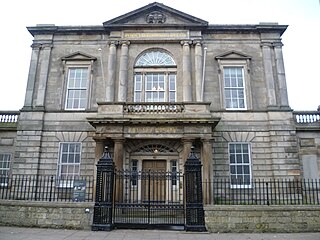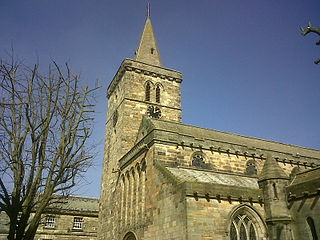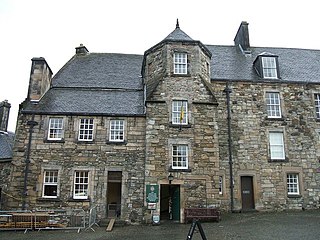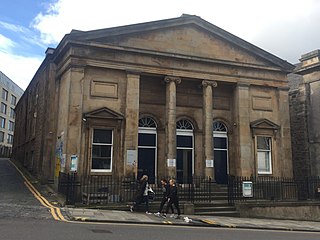
Perth is a centrally located Scottish city, on the banks of the River Tay. It is the administrative centre of Perth and Kinross council area and is the historic county town of Perthshire. It had a population of about 47,430 in 2018.

St Andrews is a town on the east coast of Fife in Scotland, 10 miles southeast of Dundee and 30 miles northeast of Edinburgh. St Andrews had a recorded population of 16,800 as of 2011, making it Fife's fourth-largest settlement and 45th most populous settlement in Scotland.

The Tron Kirk is a former principal parish church in Edinburgh, Scotland. It is a well-known landmark on the Royal Mile. It was built in the 17th century and closed as a church in 1952. Having stood empty for over fifty years, it was used as a tourist information centre for several years in the mid 2000s and, more recently, was the site of the Edinburgh World Heritage Exhibition and John Kay’s book and gift shop.

The Old Town is the name popularly given to the oldest part of Scotland's capital city of Edinburgh. The area has preserved much of its medieval street plan and many Reformation-era buildings. Together with the 18th/19th-century New Town, and West End, it forms part of a protected UNESCO World Heritage Site.

The Church of the Holy Rude is the medieval parish church of Stirling, Scotland. It is named after the Holy Rood, a relic of the True Cross on which Jesus was crucified. The church was founded in 1129 during the reign of David I, but the earliest part of the present church dates from the 15th century. As such it is the second oldest building in Stirling after Stirling Castle, parts of which date from the later 14th century. The chancel and tower were added in the 16th century.

Restalrig is a small residential suburb of Edinburgh, Scotland. It is located east of the city centre, west of Craigentinny and to the east of Lochend, both of which it overlaps. Restalrig Road is the main route through the area, running from London Road, at Jock's Lodge, to Leith Links. It is in the ward of Lochend.

Trinity College Kirk was a royal collegiate church in Edinburgh, Scotland. The kirk and its adjacent almshouse, Trinity Hospital, were founded in 1460 by Mary of Gueldres in memory of her husband, King James II who had been killed at the siege of Roxburgh Castle that year. Queen Mary was interred in the church, until her coffin was moved to Holyrood Abbey in 1848.

A crown steeple, or crown spire, is a traditional form of church steeple in which curved stone flying buttresses form the open shape of a rounded crown. Crown spires first appeared in the Late Gothic church architecture in England and Scotland during the Late Middle Ages, continued to be built through the 17th century and reappeared in the late 18th century as part of the Gothic Revival.

There have been several town walls around Edinburgh, Scotland, since the 12th century. Some form of wall probably existed from the foundation of the royal burgh in around 1125, though the first building is recorded in the mid-15th century, when the King's Wall was constructed. In the 16th century the more extensive Flodden Wall was erected, following the Scots' defeat at the Battle of Flodden in 1513. This was extended by the Telfer Wall in the early 17th century. The walls had a number of gates, known as ports, the most important being the Netherbow Port, which stood halfway down what is now the Royal Mile. This gave access from the Canongate which was, at that time, a separate burgh.

Trinity House, 99 Kirkgate, is a building in Leith, Edinburgh, Scotland, which was a guild hall, customs house, and centre for maritime administration and poor relief. In the Late Middle Ages and Early Modern Era it also served as an almshouse and hospital. Now in state care, it houses a maritime museum. It is a category A listed building.
John Douglas of Pinkerton was a Scottish architect who designed and reformed several country houses in the Scottish Lowlands. His work deserves to be noted for what the 2002 history of Scottish architecture remarks as an approach "of relentless surgery or concealment.". His most notable works are Killin and Ardeonaig Church, Stirlingshire (1744); Archerfield House, East Lothian (1745); Finlaystone House, Renfewshire (1746–47), Wardhouse (Gordonhall), Insch, Aberdeenshire (1757); and Campbeltown Town Hall, Argyll and Bute (1758–60). Several of these are listed buildings.

Holy Trinity Church is a Church of Scotland parish church in St Andrews, Fife. It is a Category A listed building.

Walter Merlioun, was a Scottish master mason based in Edinburgh.

The Collegiate Church of St Mary in the Fields was a pre-Reformation collegiate church in Edinburgh, Scotland. Likely founded in the 13th century and secularised at the Reformation, the church's site is now covered by Old College.

St John's Kirk is a church in the Scottish city of Perth, Perth and Kinross. Of Church of Scotland denomination, it is located in St John's Place, just southeast of the city centre. It stands on the former site of a church dating to 1126. Today's structure, built around 1448, is a Category A listed building. The church is most noted for being the site of John Knox's 1559 sermon against idolatry, which began the Scottish Reformation.
William Erskine Thomson was a Scottish architect prominent in the late 19th and first half of the 20th centuries. He designed several notable buildings in Scotland, mostly including churches and villas. Several of his works are now listed structures.

St Oran's Church was a Gaelic-speaking congregation of the Church of Scotland in Edinburgh. Originating in the early 18th-century, the congregation continued until 1948, latterly meeting at Broughton Street.















